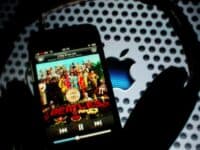
Apple Inc.’s (NASDAQ: AAPL) massive success currently rests with a relatively small collection of products. 24/7 Wall St. looked at Apple’s revenue by product lines, the specific products in those categories and, in some cases, which of these products are sold by outside retailers, particularly the big three wireless companies: AT&T, Verizon Wireless and T-Mobile.
In the year that just ended, Apple’s revenue was $274.5 billion. Of this, 50% came from the family of iPhone versions, 10% came from the Mac product line, 8% came from the iPad product line and 11% came from “wearables,” which are mostly the Apple Watch and iPods. The balance was non-hardware products in the category called “services.”
A look at the lineup of products sold by the three wireless companies shows that the Apple iPhone lineup is broad, and it ranges from the new iPhone 12 to products as old as the iPhone 6, which was first launched in 2014.
Based on AT&T’s list of smartphones promoted to customers, the popularity of models runs in this order: the iPhone 11, iPhone 12, iPhone SE, iPhone XR, iPhone XS Max, iPhone 6s and iPhone XS. The iPhone 11 was Apple’s flagship product until last fall, so its place at the head of the order makes sense. The product line shows how wide the price range of Apple iPhones is. The iPhone 12 Max carries a price as high as $1,400. The iPhone 6s costs as little as $450. Features across the versions vary considerably. AT&T, like its rivals, sells the phones in 24 monthly installments to retain customers and cut down the price of the iPhones to an affordable level.
The iPad comes in four basic versions: iPad Pro, iPad Air, iPad and iPad mini. The iPad and iPad Air are new products, each part of Apple’s eighth generation of the product. The other two are in the fourth generation of their product lines. Apple sells the iPad Pro with cellular and wireless service for $1,149. It comes with a 12.9-inch screen. The iPad Air, with a 10.9-inch screen, is priced as high as $729. The new iPad carries a price as high as $459.
The Mac product line is made up of seven versions: MacBook Air, MacBook Pro 13 inch screen and MacBook mini, each of which is a new product. Older products include the MacBook Pro 16 inch, iMac, iMac Pro and MacBook Pro. The lowest-priced MacBook Pro costs $999. The MacBook Pro 16 inch costs $2,399 and can cost more with a series of special features. The MacBook Air carries a price as low as $899 and as high as $2,799
As mentioned, among wearables, the primary product lines are the smartwatch and iPods. Apple Watch comes in five versions: the Series 6, the SE, Series 3, Apple Watch Nike and Apple Hermes. Series 6 carries a price as high as $799. The Series 3 price point can be as low as $199. The Hermes version carries a price point as high as $1,399.
The iPods fall into three versions: the base version, iPods Pro and the new iPods Max. The base version costs $159. The highest-priced Max is $549.
The number of products Apple sells is actually relatively small for a company with revenue of over $275 billion, but simplicity is part of Apple’s success. (The most expensive product, eventually, will be the Apple Car, rumored to be released in 2024.)
Apple may launch an email product.
100 Million Americans Are Missing This Crucial Retirement Tool
The thought of burdening your family with a financial disaster is most Americans’ nightmare. However, recent studies show that over 100 million Americans still don’t have proper life insurance in the event they pass away.
Life insurance can bring peace of mind – ensuring your loved ones are safeguarded against unforeseen expenses and debts. With premiums often lower than expected and a variety of plans tailored to different life stages and health conditions, securing a policy is more accessible than ever.
A quick, no-obligation quote can provide valuable insight into what’s available and what might best suit your family’s needs. Life insurance is a simple step you can take today to help secure peace of mind for your loved ones tomorrow.
Click here to learn how to get a quote in just a few minutes.
Thank you for reading! Have some feedback for us?
Contact the 24/7 Wall St. editorial team.




